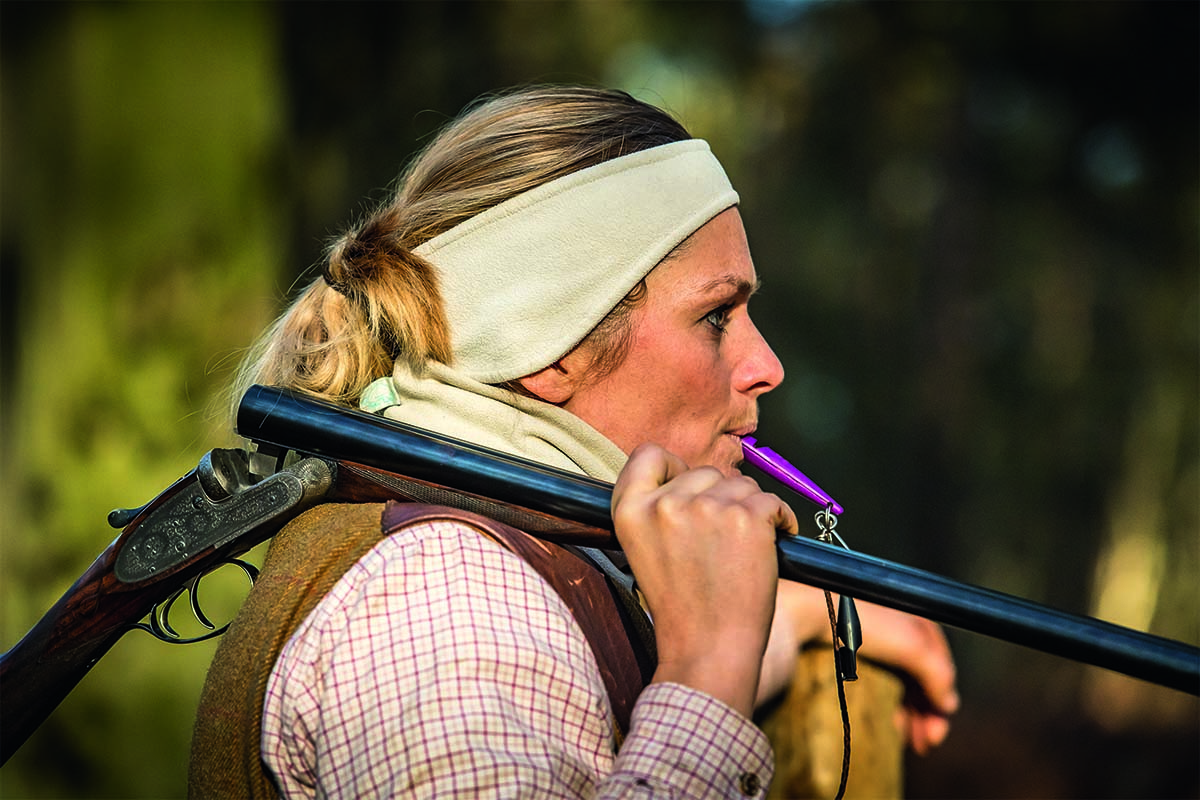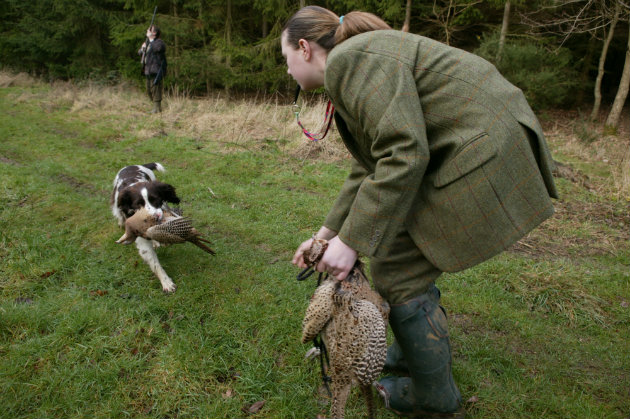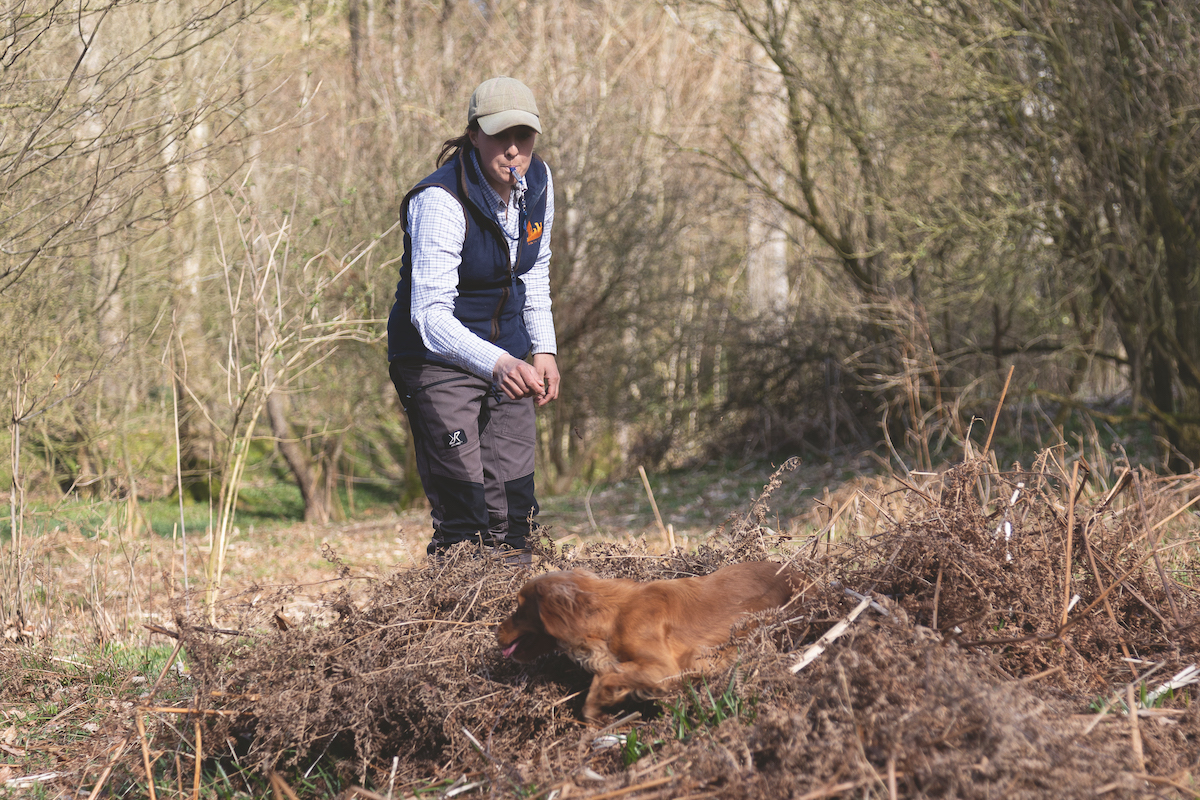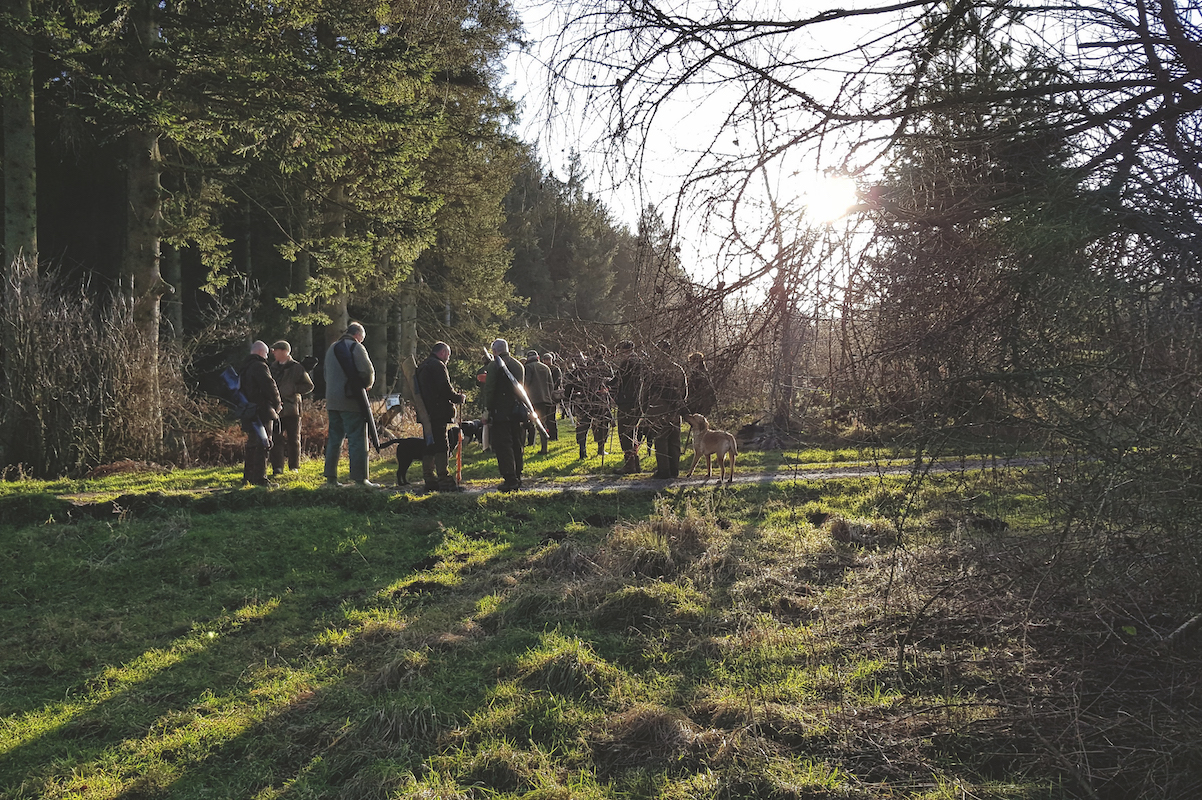Dog training with a whistle: some frequently asked questions
A whistle is a very useful tool when you know how to use it correctly

Ellena working her dogs
Dog training with a whistle means you don’t have to shout yourself hoarse when you’re teaching your hound how to behave. (Read how to teach reliable dog recall.)
Having a whistle in your pocket is a useful tool and of course different blows on the whistle can mean all sorts of different things to a dog. You only have to look at sheepdogs to see how well trained a dog can be to the whistle.

An impeccably trained sheepdog reacting to the whistle
However, it’s not always as simple as all that. Get dog training with a whistle right and you’ll have a well behaved dog that knows how to react to key commands. Get it wrong and you won’t be welcome in the field. (Read our tips on how to use a slip lead correctly.)

A whistle can be a useful tool in the field
Dog training with a whistle
To help things along, here is a list of questions that our readers frequently ask about. You’ll find more useful articles on gundog training here.
Different whistles for dogs and bitches?
Q: I was told years ago that bitches heard a 210.5 whistle better and dogs a 211. Is there any truth to this or is it dependent on breed? I have read such conflicting advice.
A: Whistle pitch is more to do with the job you want the dog to do, rather than specific to breed or sex. I haven’t yet come across any research to suggest otherwise. Spaniels are normally on a 210.5 as it is higher pitched and doesn’t carry over long distances as well. Spaniels are rarely required to hunt or handle at long ranges and so tend to use this whistle. A 211 or even 212 are slightly lower pitch and carry across much greater distances, so are more commonly used for retrievers and HPR breeds that are meant to work farther out. I have two whistles for my retrievers (211 and 212) but only use the 212 if the conditions make it extremely difficult for the dog to hear. Decide what you want from your dog, rather than looking at breed or sex, and choose the appropriate whistle. Acme Whistles has a wealth of information available and is the best company to advise on such matters.
Clearing up stop-whistle confusion
Q: I am really confused on the stop whistle and have read all sorts of different information. I have seen many videos on teaching it that say the dog has to sit when I ask. However, when I watch more advanced dogs, none of them sit, but stand and look at the handler. My trainer told me I must make the dog sit, but he has started to stand and look at me. Is this a problem? (Read more on using the stop whistle here.)
A: It is most commonly called a ‘stop whistle’ because actually all that is required is for the dog to stop and look. A better description could be an ‘attention’ or ‘look’ whistle as essentially this is all we want from them. I don’t tend to start mine off by asking them to sit, as I find this very static and awkward and most (as you have observed) naturally transition to a stand anyway. If your dog stops and gives you immediate focus when you blow the whistle, I would be extremely happy and not enforce a sit. Occasionally, if a dog is a bit fidgety with the stop whistle — it stops for a split second and then moves on — I may ask for a sit just to settle them a bit before asking them to move on. Every trainer has their own way and reasons, but remember they need to suit you and your dog. It sounds like yours is doing a great job. (Ellena Swift)
Different whistle for different breeds?
Q: When dog training with a whistle do different gundog breeds need different whistles? Why are 210.5 whistles recommended for spaniels, but 211.5 for labradors and retrievers?
The number refers to the pitch of the whistle, and for some reason a 210.5 is always referred to as a two-ten-and-a-half, and a 211.5 as two-eleven-and-a-half.
There is no difference in the hearing of a labrador or a spaniel, or for that matter a poodle or a pointer. All dogs, regardless of breed, hear a frequency range of 40Hz to 60,000Hz, while the human range is between 20Hz and 20,000Hz. This explains why a dog can register a so-called silent whistle, which is sufficiently high-pitched to be inaudible to the human ear. Choice of whistle comes down to the handler’s individual preference and it really doesn’t make any difference to the dog.
Once you have bought your first whistle you are likely to remain faithful to the same one for the rest of your life. (You might also like to read about hearing loss in dogs.)

Only send your dog for the retrieve when it is looking at you
Stop whistle
Q) I have a young springer spaniel that I am training. I would like to know how to use the stop whistle. How do I make my dog steady to it? What’s the secret of dog training with a whistle? (You’ll find more on training a dog to the stop whistle here.)
A) The whistle is not a magic device to stop bad behaviour and experienced gundog trainers have no magic formula or secrets when teaching a dog to respond to it, or to any other commands.
Rather, the dog is taught to respond to the whistle using positive reinforcement during training to condition the required response.
To the puppy, a single pip on the whistle means a reward, if it immediately stops what it is doing and sits down. (Read how should I start training my puppy to be a gundog.)
Once basic obedience has been taught, the puppy will have been conditioned through repetition and reward for every correct response to sit (stop) on various commands , including a voice command ‘sit’, a raised open hand, a clap of the hands and a single pip on the whistle.
However, simply because a puppy reacts instantly to a command when it is near does not mean it will automatically do so at a distance.
- Ensure you establish authority through the early training so the puppy is looking for guidance and, of course, reward.
- Gradually increase the distance when giving the command and only give it when you are certain it will be obeyed and you can confirm the response with a reward.
- If you use common sense and are patient over a period of several weeks, a puppy will become conditioned to respond obediently to any command.
- It is no use rushing through training then expecting to find a cure after the dog has developed complex bad habits in the shooting field.
My dog has gone off the whistle!
Q: My springer was great at recalls during the summer using a black plastic high-pitched whistle with a pea in it, but since the season started he has been going beating two or three times a week and now he does not seem to hear it any more. A friend suggested a silent dog whistle. Would that work better?
A: It is more likely that working on live game has aroused his nose to such an extent that his ears are switching off when he is distracted by hot scent. A different whistle is not the answer but some urgent remedial training is essential to recapture full control. A dog does not respond to a whistle because of some in-built natural instinct — it must be taught to respond to it through training.
- A command, from any type of whistle, should be taught so that every time the dog hears a pip, it is a cue for getting something pleasant as a reward.
- At present, he is getting far more pleasure through his nose and finding game. Go back to basics in the training environment for a while and make sure he is perfect on the whistle, using positive reinforcement for all correct behaviour.
- Even a pip on the whistle should gain a quick response from him in ideal conditions.
- If constantly rewarded with high-value treats, and repeated often enough, this pip will become associated by the dog with paying attention to you.
Once this has been achieved, the next progression should be easy. Pip the whistle to gain attention and then recall to give him the reward. This will mean a break from the shooting field until you have got him focused and responding to the whistle once again, but it will be worth it in the end.
Avoid not giving “rewards”
Q: Over the summer my labrador has been very sloppy on the stop whistle, is there any way I can get him a bit sharper?
A: Let’s assume that at some point your dog was sharp on the stop whistle. During the summer you may have relaxed your regime and he has got away with ignoring your commands. Make no mistake: dogs get bored of hearing the stop whistle without any ‘reward’ in the shape of a directional signal, or a flush. One technique you can usefully use is to blow the whistle and throw out a dummy (assuming the dog is totally steady) and only send him for the retrieve when he looks back to you. Don’t overdo this – the aim is to condition the dog into believing that every time he hears the whistle something good will happen.
Blow hard or soft?
Q: How hard should I blow my gundog whistle?
A: How you blow the stop whistle really depends on the type that you use. Most whistles are numbered from 210 to 211.5. Many gundog trainers use use two pips and a hand signal to turn a gundog and one short blast to stop. For ‘normal’ commands blow very lightly.
To stop a chase situation blow slightly harder to get the command across, and understood. Remember that a dog’s hearing is probably ten times more acute than our own so you don’t have to blow hard on the whistle to get its attention.
Working on eye contact
Q: Is there any way you can improve a dog’s eye contact? My labrador tends to look here, there and everywhere – but not at me – when he stops to the whistle. I’m beginning to think I have gone wrong somewhere in his training, but I don’t know where.
A: Eye contact is a very special thing between handler and dog which is developed in the early training process, and more particularly the way you are training it.
Some dogs are just naturals at establishing trust with eye contact but others you have to work on; talking to the dog as you walk along is one way of doing it. And another is to praise the dog the moment it looks at you, coupled with a hand command making it sit.
Another great opportunity for making eye contact and getting the dog to focus on what you’re doing comes when you introduce it to whistle commands. Similarly, when dummy retrieving it pays to throw one but always keep hold of another – the dog soon learns to look back to see what you are going to do with it.

Silent whistle?
Q: I will soon be training my first labrador gundog. What sort of whistle should I use, as I am considering using the silent type?
A: (Peter Blatch replies) There are several different types of dog whistles available and the one I favour for labradors is the 211.5
I have never used silent whistles on labs because the other type tends to work best. That said, silent whistles for some reason seem to be favoured more by people training a spaniel.
Regardless of breed I stick to the same whistle because I can hear its tone perfectly and get the commands exactly right every time – the most important ones being a long blast to stop the dog and several sharp pips to come in or, in the case of a spaniel, two quick pips to turn it. The good old 211.5 allows me to do this consistently so there is no confusion in the dog’s mind when he hears the whistle go.
The main disadvantage with a silent whistle is it’s made of metal, which makes it heavy to hold between the teeth and very uncomfortable in cold weather.
The ready availability of the 211.5 is another point in its favour, because if you lose one it can then be quickly replaced, and cheaply.
By all means give a silent whistle a trial, but in my experience when working labradors at a distance the sound of the 211.5 carries far greater distances than the silent type.
Turning a deaf ear
Q: My three year old gundog responds perfectly to whistle commands on dry land but but once he’s in water and swimming for a retrieve he turns a deaf ear. How can I get him to listen to the whistle when he’s in water?
Being able to command a gundog when it’s out in water is always going to be tricky.
The first rule is to get the dog to respond 100% to the whistle on dry land and then ease the dog gradually into the water.
The biggest mistake is to start by giving your dog a difficult retrieve out in the water because in this situation he’s more likely to ignore the whistle and try to take control of the situation.
- Make the first retrieve simple by placing the retrieve close to the bank then progress to throwing two retrieves, one to the left and one to the right.
- Send the dog to one, stop it mid-way and then redirect it to pick up the other retrieve.
- Because the dog is close to the bank you should be able to make it listen and respond to your commands.
Do not under any circumstances let the dog do its own thing. Keep things simple and then advance to longer retrieves as your control grows. (Read more about keeping your dog safe on a shoot.)
This article was originally published in 2014 and has been updated.














